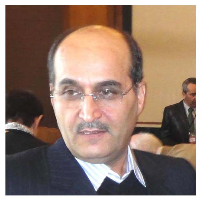Analysis of factors affecting on hydrodynamic of Arvandrud delta coastline during 1955- 2016
Author(s):
Article Type:
Research/Original Article (دارای رتبه معتبر)
Abstract:
A shoreline is defined as the line of contact between land and a body of water (Bird, 2011). The most effective processes on coastal morphology change are wind, wave, marine current, tides and human activity (El-Mrini et al, 2012. Moussaid et al, 2015). Prodelta of Arvandrud delta as the largest delta of the Persian Gulf, has very low slope in foreshore. Historical data of the last 60 years show the shoreline has been a lot of transgression and degradation. The aim of this study, is Evaluation of shoreline displacement rate and the factors affecting on its.
Dynamic of water and sediment flow transport of Arvandrud to the shoreline, has been introduced as the main factor of propagation in this part of Persian Gulf shoreline. Delta-making process had been largest area between the years 1955-1973
Materials and methods
In order to have an understanding of the effective factors on shoreline change, flow rate and sedimentary of Ahvaz (Karun) hydrometric stations statistics, area tidal data, wave rose, wind rose and current rose were processed. For determining the place and time changes in the shoreline, Cartosat (2011), Landsat (1973, 1982, 1994, 2002, and 2016) satellite imagery and aerial photographs (2016) were used. To calculate the rate of the shoreline changes, DSAS (Digital Shoreline Analysis System) method was used. In this article, upper limit of tidal zone (Diurnal) was selected as shoreline for all of time periods.
Results and discussion
Shoreline position in the study of periodic changes between the years 1955-2016 show shoreline has been progradation in the most areas. Increasing over 3.98 KM during the last 60 years indicates this sedimentation rate in shoreline. Shoreline progradation, has been notable at the mouth of the Arvandrud. Recent progress is related to the period 1955 - 1973. Relatively stable parts are most in the east of the area. These areas have been old mouths of Karun River, which has been now converted in to the estuary. The speed of dominant wind is 3/5 m/s and frequency is 62%. Since the direction of dominant winds of the region are northwest, wind factor can’t play an effective role on the shoreline morphology changes of this region. Dominant waves directions also are to the NW. 72% wave’s heights are between 0.02- 0.99 meters. Only affective waves in this area are waves with southwest and south east (diagonal) direction, which according to the frequency and less height wave and very low slope of the nearshore break farthest from the shore. Marine currents direction are NW-SE in this area. This current carries water and sediment of Arvandrud and Bahmanshir rivers from east to west. More than 51% of Marine flows have the velocity between 0-0.05 cm/s that can affect shoreline morphology. Studies show the level of the tide in this area of the Persian Gulf (except Khore Musa) reaches its maximum. Maximum and minimum height of sea water are 322 cm and 32 cm ,respectively that progress in land (backshore).To understanding the reasons of the shoreline progress, during dam constructing upstream of Karun river in Ahvaz, especially from 1975 until now, trend of water and sediment discharges into the mouth of Arvandrud has been gradually reduced. The years of 1973-1955, Karun River has experienced one of the high peaks of water and sediment flow to the Arvandrud, this has been coincided with the most shoreline progradation. An increase in the flow rate and deposition in this period correspond to the time with less number of built dams on the Karun River in comparison with the next periods.
Conclusion
Dynamic of water and sediment flow transport of Arvandrud to the shoreline, has been introduced as the main factor of propagation in this part of Persian Gulf shoreline. Delta-making process had been largest area between the years 1955-1973.This progradation has been associated with one of the highest peaks of water and sediment flow to Arvandrud. Marine currents (local scale) with direction of east to west and Coriolis factor with regional scale have had a major role and are responsible in shaping of shoreline convexity and development of spits to the west. The results of this study have been conformed more or less to findings of Yamani et al (1392) for the period 1977-2005 and Ranjbar and Iranmanesh (1390) for the period 1955-1992Dynamic of water and sediment flow transport of Arvandrud to the shoreline, has been introduced as the main factor of propagation in this part of Persian Gulf shoreline. Delta-making process had been largest area between the years 1955-1973
Keywords:
Language:
Persian
Published:
Physical Geography Research Quarterly, Volume:50 Issue: 104, 2018
Pages:
339 to 352
magiran.com/p1912867
دانلود و مطالعه متن این مقاله با یکی از روشهای زیر امکان پذیر است:
اشتراک شخصی
با عضویت و پرداخت آنلاین حق اشتراک یکساله به مبلغ 1,390,000ريال میتوانید 70 عنوان مطلب دانلود کنید!
اشتراک سازمانی
به کتابخانه دانشگاه یا محل کار خود پیشنهاد کنید تا اشتراک سازمانی این پایگاه را برای دسترسی نامحدود همه کاربران به متن مطالب تهیه نمایند!
توجه!
- حق عضویت دریافتی صرف حمایت از نشریات عضو و نگهداری، تکمیل و توسعه مگیران میشود.
- پرداخت حق اشتراک و دانلود مقالات اجازه بازنشر آن در سایر رسانههای چاپی و دیجیتال را به کاربر نمیدهد.
In order to view content subscription is required
Personal subscription
Subscribe magiran.com for 70 € euros via PayPal and download 70 articles during a year.
Organization subscription
Please contact us to subscribe your university or library for unlimited access!



